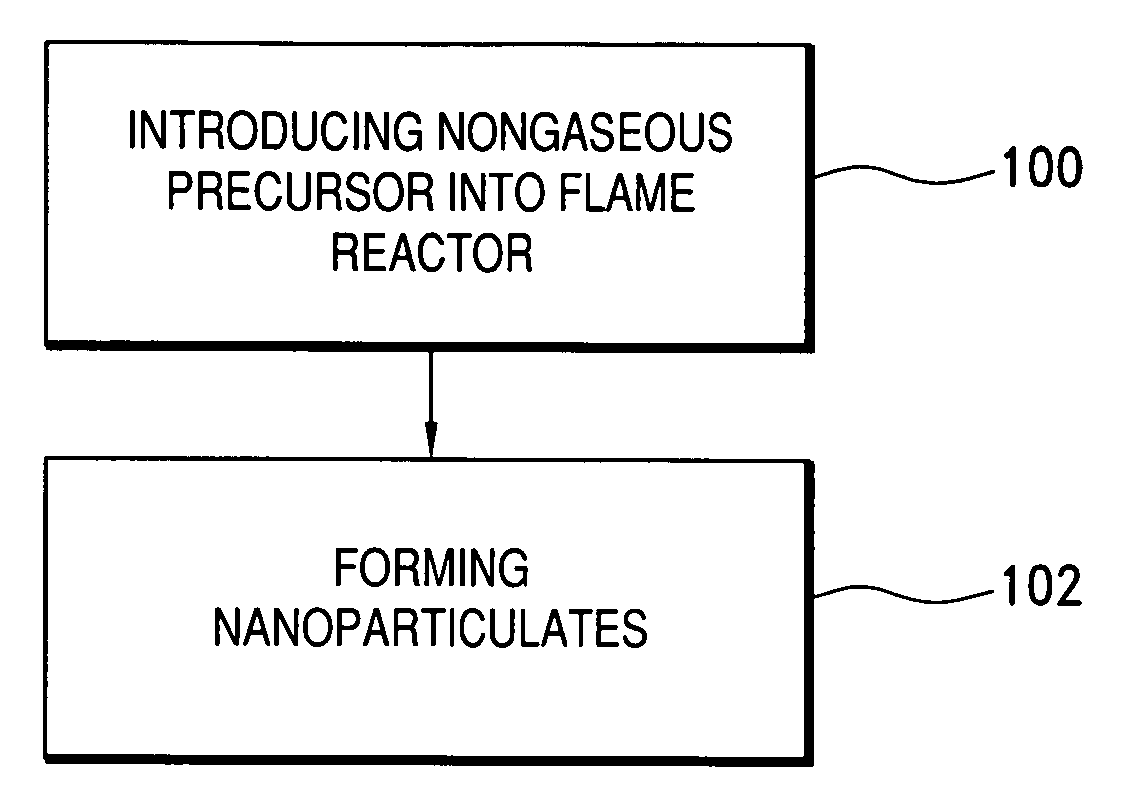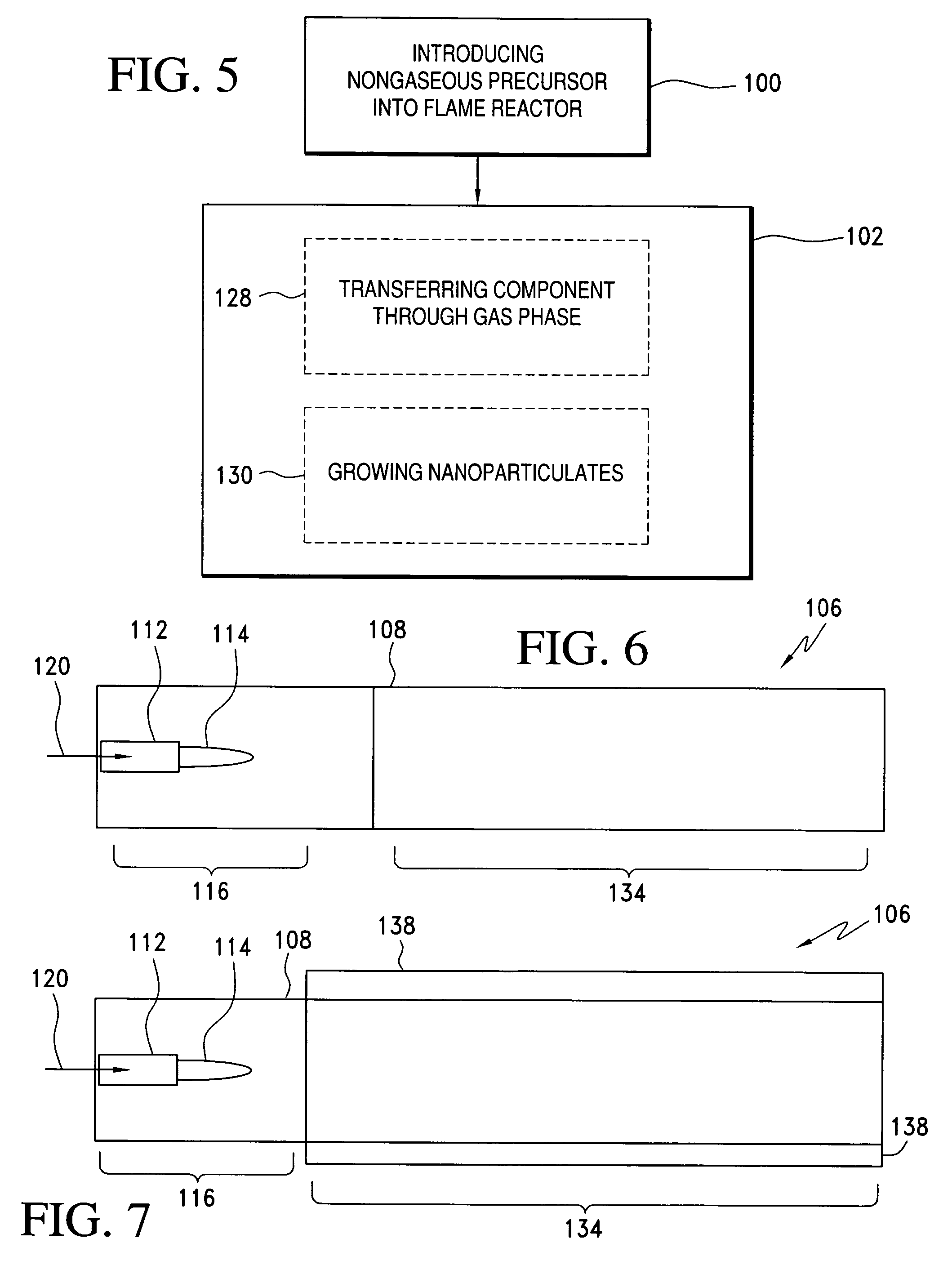Method of making nanoparticulates and use of the nanoparticulates to make products using a flame reactor
a technology of flame reactor and nanoparticulate, which is applied in the direction of metal/metal-oxide/metal-hydroxide catalyst, magnetic body, silicate, etc., can solve the problems of significant size range of nanoparticulate and other properties
- Summary
- Abstract
- Description
- Claims
- Application Information
AI Technical Summary
Benefits of technology
Problems solved by technology
Method used
Image
Examples
example 1
Synthesis of Cerium Yttrium Aluminum Garnet (YAG) Powder
[0245] Cerium 2-ethylhexanoate, yttrium 2-ethylhexanoate, and aluminum diisopropoxide ethylacetoacetate mixed with toluene is used as the precursor solution for the synthesis of ceria doped YAG powder. The metal weight percent of cerium, yttrium, and aluminum in the precursor solution are 0.1, 3, and 1.5 respectively. The precursor flow rate and dispersing oxygen flow rate were 15 ml / min and 25 SLPM, respectively. The surface area of particles varied from 66 m2 / gm to 71 m2 / gm. The scanning electron microscopy (SEM) and tunneling electron microscopy (TEM) analysis shows that particles are non-agglomerated with the primary particle size varying from 10 to 75 nm. The quasi-elastic light scattering analysis using a Malvern instrument showed that intensity average particle size is 176 nm when a lower temperature reactor was used, and the intensity average particle size of 150.1 nm when higher temperature reactor was used. The synth...
example 2
Synthesis of Europium Doped Yttria Powder
[0246] Europium 2-ethylhexanoate, and yttrium 2-ethylhexanoate mixed with toluene is used as the precursor solution for the synthesis of europium doped yttria powder. The metal weight percent of europium, and yttrium in the precursor solution are 0.5 and 3.4 respectively. The precursor flow rate and dispersing oxygen flow rate were 15 ml / min and 25 SLPM, respectively. The surface area of particles varied from 45 m2 / gm to 63 m2 / gm. The SEM and TEM analysis shows that particles are crystalline and mostly non-agglomerated with the primary particle size varying from 10 to 40 nm. The quasi-elastic light scattering analysis using a Malvern instrument showed that intensity average particle size is 198.7 nm when lower temperature reactor was used, and the intensity average particle size of 146.8 nm when higher temperature reactor was used. The synthesized europium doped yttria powders can be used as a phosphor.
example 3
Synthesis of Zinc Oxide Powders
[0247] Zinc 2-ethylhexanoate mixed with toluene is used as the precursor solution for the synthesis of zinc oxide powder. The metal weight percent of zinc in the precursor solution varied from 5.1 to 5.4. The precursor flow rate and dispersing oxygen flow rate were 15 ml / min and 25 SLPM. The surface area of particles varied from 26 m2 / gm when lower temperature reactor was used to 28 m2 / gm when higher temperature reactor was used. The SEM analysis shows that particles are rod shape and mostly non-agglomerated with the primary particle size varying from 20 to 200 nm. The quasi-elastic light scattering analysis using a Malvern instrument shows that intensity average particle size is 230.1 nm. The synthesized zinc oxide powders can be used in cosmetics, and as variable resistors in solar cells.
PUM
| Property | Measurement | Unit |
|---|---|---|
| Temperature | aaaaa | aaaaa |
| Volume | aaaaa | aaaaa |
| Particle size | aaaaa | aaaaa |
Abstract
Description
Claims
Application Information
 Login to View More
Login to View More - R&D
- Intellectual Property
- Life Sciences
- Materials
- Tech Scout
- Unparalleled Data Quality
- Higher Quality Content
- 60% Fewer Hallucinations
Browse by: Latest US Patents, China's latest patents, Technical Efficacy Thesaurus, Application Domain, Technology Topic, Popular Technical Reports.
© 2025 PatSnap. All rights reserved.Legal|Privacy policy|Modern Slavery Act Transparency Statement|Sitemap|About US| Contact US: help@patsnap.com



